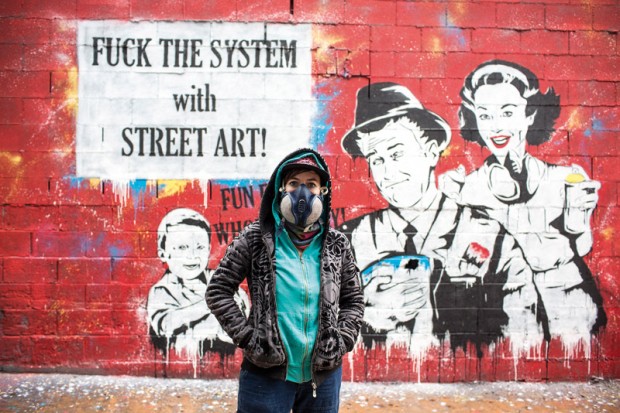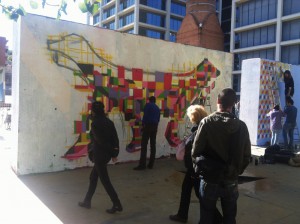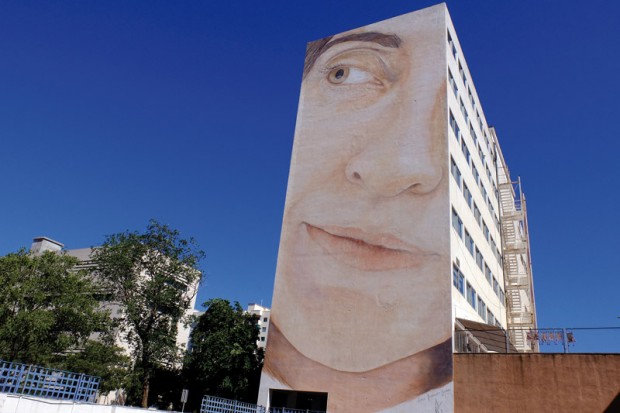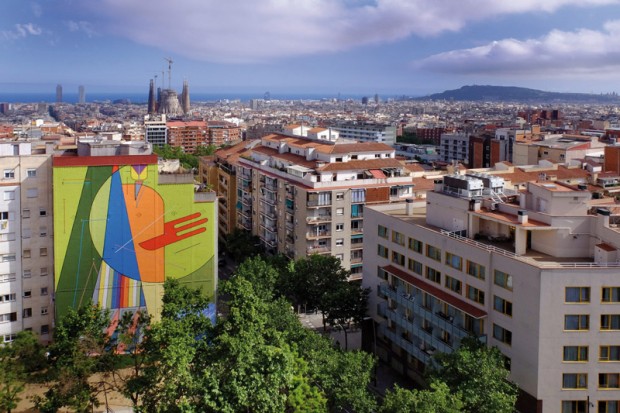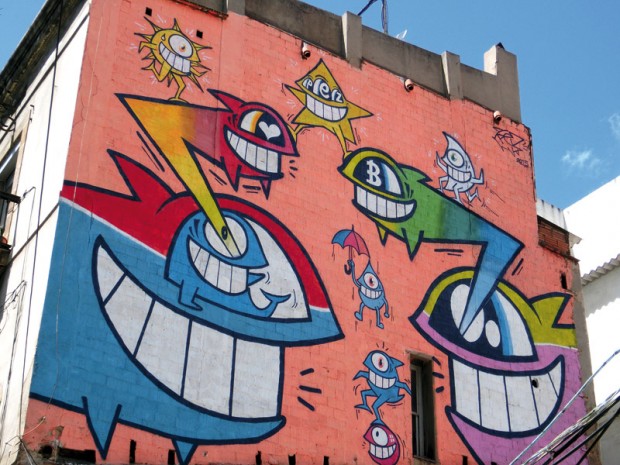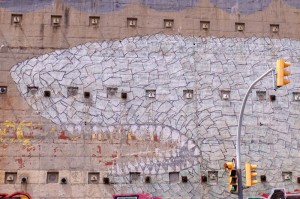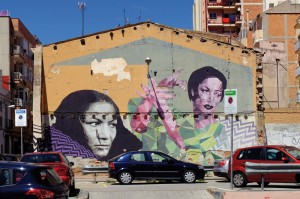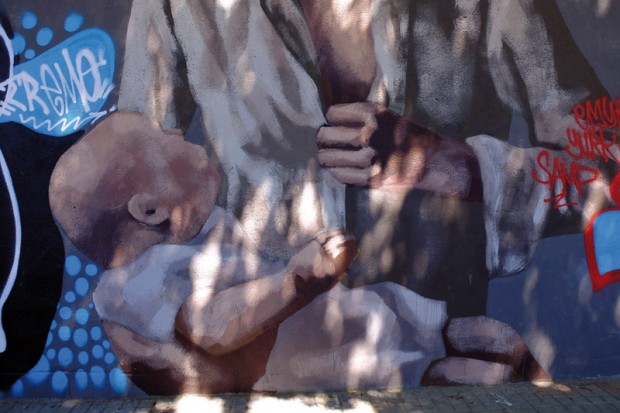
A mural by the Argentinean artist Hyuro, on Passeig de la Circumval•lació in Ciutat Vella, painted during the 2016 La Mercè festival as part of the Transit Walls project.
Photo: Vicente Zambrano
Since the appearance of the first graffiti in the mid-1980s, Barcelona has had a rather tempestuous relationship with this new form of artistic expression in its public space. Over a 30-year period we have gone from freedom to an outright ban, and now, slowly but surely, to a dialogue and consensus that is still very loosely defined today. There are three main characters in this story: the artists, the authorities and the public. In the following pages we will analyse how their relationship has evolved over the last three decades.
In the documentary BCN Rise&Fall, Pedro Calado claims that to reinvent a city, one has to mix three T’s: talent, technology and tolerance. The future is an open road. Today, the reinvention of Barcelona means debating how urban art should be integrated into the way the metropolis functions. We have the three T’s. We just need to steer them in the right direction.
Before we talk about Barcelona’s relationship with urban art, we need to define the terms “graffiti” and “urban art”. Graffiti is script painted repeatedly with spray paint or marker pens, through which the author – who tends to be part of a closed, established group or gang – seeks notoriety and marks group territory. The simplest graffiti takes the form of tags or signatures of the graffiti writers’ pseudonyms. The most complex are “throw-ups”, or graffiti in which the letters are painted large and in a voluminous style. The concept of urban art also encompasses a whole range of temporary artistic expressions in the street, using many different media: adhesives, stencilling, mosaics, etc. The artist creates them with the aim of reaching the largest audience possible, drawing the attention of the public, transforming public spaces, surprising or criticising. In short, making us see that things can be different and taking art out of museums.
Many urban artists started out in the world of graffiti, and some examples of graffiti are so beautifully created that they could be classed as urban art. So graffiti and urban art share an overlapping space that often leads the general public to lump them together, and this can lead to a lack of understanding or tolerance on the part of both the authorities and the public.
Graffiti originated in New York in the 1970s and was linked to the hip-hop culture developed by gangs in neighbourhoods like the Bronx and Queens. It reached Barcelona in the mid-1980s through the influence of rap music and American movies. The documentary Style Wars was particularly influential. For years, every Sunday would find hundreds of teenagers from different social classes, who called themselves “b-boys”, meeting in the ticket hall of Universitat metro station, which became the perfect place for break dancing, rapping and graffitiing. The idea was to paint in the metro or on the urban furniture, illegally and organising themselves into areas and forming gangs like Yeah! or Golden ASC. They painted tags en masse, and the largest examples were reserved for more remote places or areas where the police couldn’t enter without a warrant.
They painted for the excitement of doing something illegal, to feel important or just to do something out of the ordinary, aware that if they didn’t do anything too serious the police wouldn’t say anything. In the beginning, it was a relatively small group that competed to see who did the best writing in the space available. However, they soon switched spray cans for marker pens, because the latter instruments made it faster to write and simplified the style while increasing the number of tags. In these early years, the products they used were difficult to find and expensive for teenagers. So they often used low-quality products that they bought or stole, or they made their own pens using the pots that contained photographic film, or blackboard erasers.

A reproduction of the mural Todos juntos podemos parar el sida (Together We Can Stop AIDS) by Keith Haring, originally painted in Plaça de Salvador Seguí in 1989, on the walls of MACBA in 2014.
Photo: Vicente Zambrano
Because most of the action took place in the metro’s facilities, Transports Metropolitans de Barcelona (TMB) managed the problem by implementing a three-fold strategy. Firstly, it invested considerable resources into cleaning away tags on a daily basis: in 1990, 60 million pesetas (€360,608) were initially spent on this, rising to 100 million (€601,013) two years later. Secondly, it drew up a catalogue of signatures to be used as evidence in legal cases. Drawing graffiti was a civil offence ruled through administrative action, carrying a potential fine of over 100,000 pesetas (€601), which could be offset by cleaning walls. Lastly, TMB made spaces available for painting. The rule was simple and the conditions pretty good. The company offered Golden ASC a wall in the Universitat metro station, which became the first legally graffitied wall. Soon thereafter, another wall was provided in the Drassanes metro station. Despite this, relations with these groups of youngsters were uneasy and intermittent, as gangs often changed members and, therefore, their spokespersons.
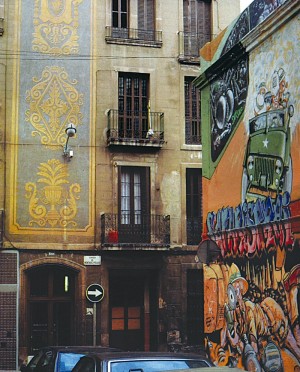
A page from the book Barcelona murs (Barcelona Walls) with an image of the legendary mural Safari spray, painted with authorisation from the City Council in 1988 on Carrer de Jaén in Gràcia.
Photo: Antonio Lajusticia
The City Council did not prioritise penalisation, but rather sought to channel the phenomenon into new forms of art. It scrubbed out tags but left artistic murals. In some cases, it even gave them active support. In 1988, it provided a wall in Passatge Jaén for the legendary mural Safari Spray, and in 1989 it authorised Keith Haring to create a mural against AIDS on Carrer Salvador Seguí.
In the art world, galleries and museums began to take an interest in the work of artists who started out doing graffiti, like Jean-Michel Basquiat. Some showed compilations of Barcelona graffiti painted by both well-known and anonymous artists. One example was “Barcelona extramuros”, an exhibition held in 1991 that led to the book Barcelona murs, which illustrated how graffiti and urban art lived side by side in Barcelona, in numerous formats and with many different messages.
From growth to a ban
From the 1990s onwards, Barcelona established itself as one of Europe’s graffiti capitals. Some of its murals were featured in Spraycan Art, a major compilation of European graffiti. There was also talk of the Barcelona graffiti style, which linked these inherently ephemeral and shifting works of art to the multiplicity and heterogeneity of postmodern culture. With the arrival of a new shop, Montana Colors, the open-minded and welcoming nature of the city and its artists, combined with lenient regulations, fostered a graffiti boom in Barcelona at a time when it was coming under persecution in many cities. The penalties were negligible, and the City Council only cleaned away the most irritating pieces and gave a reprieve to those murals that touched the artistic sensibilities of its cleaners. So neither graffiti nor urban art were actually promoted as culture, but neither were they persecuted.
News of this oasis of freedom spread quickly and led to the arrival of people from all over the world who had been driven out of other cities, and who found in Barcelona the perfect spot for hassle-free painting. The result? An unprecedented increase in painted walls, in the diversity of artistic expression and in the rotation of pieces. There were artists of every kind, and while some continued with the more traditional graffiti style others infused their pieces with incredible variety.
But this growth was starting to invade private spaces and to be found all over the public space, especially the tags. And while some graffiti writers stopped painting illegally as they became aware that they were helping to create an unkempt image that did nothing to promote the artistic value, others preferred to stay outside the law and not change their behaviour. This led to the first expressions of public rejection. Projects like CamelArte were developed to promote urban art, but the public did not respond positively. Some associations and intellectuals began to speak out against these artworks, arguing that they were a sign of sloppiness, that they incited fear and instability, and that they were illegal, costly and destructive. The pieces that were most irritating were the tags and graffiti, which often appeared on private property and urban furniture, and the rejection grew because the public knew nothing about urban art. The situation was worsened by the fact that the artistic community was a shifting one, and because some artists preferred to stay outside the law. To make matters worse, education about street art was non-existent.
And so it was that in 2006 the Council approved a set of by-laws that changed everything. Article 20 of the By-Law on Measures to Foster and Guarantee Harmonious Coexistence banned any action that visually altered the public space or any public furniture, effectively prohibiting both graffiti and urban art. And while the by-law did stipulate that artistic murals could be painted with the permission of the Council, from that moment on the authorities restricted them to a minimum. In addition, having to get through all the red tape every time one wanted to paint in the street presented an obvious impediment to artists and hindered the diversity and rotation of street art. It also represented a complete loss of freedom of expression, because the Council was now the filter that decided whether a work of art deserved to be displayed or not, even if the space used was private property. Article 21 listed the penalties, with fines ranging from €750 to €3,000. No distinctions were made between different forms of expression: it was a policy of zero tolerance. Even drawing a hopscotch grid with chalk on a Barcelona street was now an offence punishable by law.
According to Jordi Hereu, the mayor at the time, the target was tags, but the enforcement of the by-law made no distinctions. The Guardia Urbana fined any graffiti action at all, and the army of cleaners and painters were at work everywhere. From 2006 to 2010, there were 1,613 reported cases of “visual defacement of the urban environment”, and an average of €4 million were spent to erase each half-square kilometre of graffiti. Not even murals of high artistic value were respected. The goal was simply one of uniformity, with the idea of protecting historic buildings and the public space which, incidentally, was easily given over to brand advertisements with commercial interests, bringing in large sums of money. It is not known whether, with these measures, the Council was responding to the complaints and wishes of the public or whether it was actually taking the opportunity to legitimise a model of urban space that, as Manuel Delgado says, sought an image of coexistence that appealed to the dominant classes, eliminating any other form of ownership of the urban space by disallowing it and convincing the dominated public of its neutrality.
The awkward dialogue
That same year, the Council drew up a culture strategy that aimed to tackle issues such as freedom of expression and the preservation of public space as a place for meeting and dialogue. The strategy plan contradicted the by-laws that impeded freedom of expression and the dialogue between art and spectators in the public space. The Council even developed a Programme of Public Art to encourage projects that would strengthen the relationship between art and the communal space, seeing art as a social and cultural energiser.
But the only thing that came out of the Council’s approach was its desire to penalise. Why? The strategy plan was very generic and did not refer specifically to urban art. In fact, the discussions prior to the creation of the plan did not include a single representative of urban art. This is a very fast-changing community made up of many individuals with very different ideas, and it was difficult to find valid interlocutors to take part in projects or in negotiations to obtain spaces in which to create their art. Neither do we know to what extent the Council sought out opportunities for dialogue or if it simply took the chance to freely impose restrictions.
Either way, the toughening of the penalties did not have the desired effect: tags continued to proliferate all over the city, while the larger, artistic works became rarer, because of the harsh fines. Some artists opted for quicker methods like adhesives and others went to Barcelona’s neighbouring towns that had more lenient regulations, or to derelict areas. In this way, urban art turned it back on its own inherent purpose: to reach as broad an audience as possible and establish a dialogue with the spectator.
Despite this, in 2007 artists’ associations and creative projects began to pop up. These initiatives highlighted the importance of urban art, disassociating it from vandalism and defending its social and cultural aspects and the preservation of the public space. The artists who did not want to be seen as illegal saw the need to come together to develop shared projects and to negotiate with the authorities to get spaces in which they could legally paint.
From Stencil Meeting to Persianes Lliures
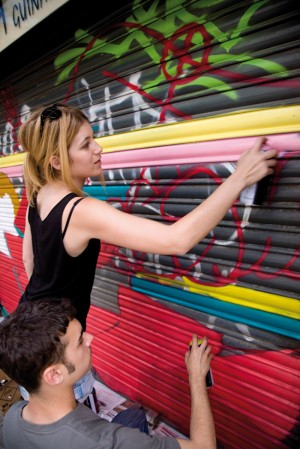
Inauguration of the Persianes Lliures project on 9 April 2010 in the Guinardó district.
Photo: Rebobinart
Also in 2007, the Difusor Stencil Meeting was organised by the Difusor artists’ collective, bringing a hundred or so artists into Barcelona to stencil several walls in Horta Guinardó, thus vindicating the use of empty, run-down spaces for art. This was no longer about graffiti, but about urban art, and it was well received by the general public. One of the walls given over to the movement gave rise to the Galeria Oberta, a space in which one could paint freely and that saw plenty of activity, although this absolute democratisation of this space was not to the liking of all artists. This brief moment of freedom did not last long, though. In 2010 the street was pedestrianised, the walls were replaced with fences and the project disappeared.
Another example of such initiatives was the “Persianes lliures” (free shutters) project. Set up in 2008 by Marc García, it allowed shop owners to go onto a website and offer up their shop shutter to be painted by a graffiti artist or urban artist. That way, part of the public space became a place for free, temporary creativity, in line with the spirit of urban art. Anybody could sign up for the project, which meant that some graffiti artists did not want to take part because they preferred to remain outside the law, abiding by their own rules and being part of an exclusive group. Other schemes, like Enrotlla’t, were set up with similar goals while bringing together groups of more established artists and offering specific pieces of work to the public markets.
However, despite the fact that these projects were intended to democratise and normalise urban art, giving new life to the environment in a collaborative manner and with minimum investment, they still had to be authorised by the Council. Red tape rendered these projects almost unviable, but over a couple of years more than 1,500 shop shutters were painted. Yet in 2010 voices of dissent were once again heard, and the Council launched the Persianes Netes (clean shutters) plan to put a stop to the projects. The plan stipulated the imposition of fines to be paid in equal halves by artists and shops.
The context has since changed, and the Council – without modifying the regulations – has had to develop forums for dialogue that highlight the need to define and agree on how to integrate these forms of artistic expression into Barcelona’s public space. The artists have changed, too, and the organisations that were set up in the darkest of days have remained strong, generating ideas and creating projects to encourage dialogue. In recent years, despite the multiplicity of visions, some interesting bridges have been built, although, as always, not everyone is in agreement.
Urban art goes up in the world
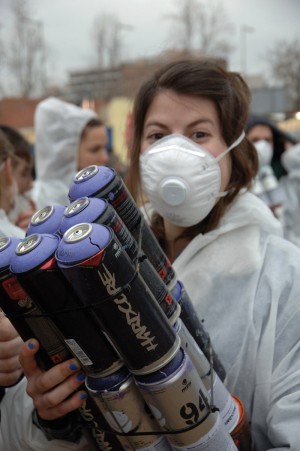
A participant in the first instalment of the urban art festival Ús Barcelona, which was held in February 2014 in the Encants Vells area.
Photo: Vicente Zambrano
It’s important to mention the change that occurred all over the world at the end of the 2000s, in terms of the spread, impact and opinion of urban art in the context of globalisation. Firstly, some creators of urban art have achieved unprecedented international prestige. One particularly good example of this is Banksy, an anonymous artist who has achieved huge fame through his actions and his stencils criticising capitalism and neoliberal society. Others, such as Shepard Fairey, have achieved international success by blurring the boundaries between urban art, conventional art and merchandising. Even contemporary art museums such as London’s Tate Modern have been exhibiting works by urban artists, some of whom, like SixeArt, are part of the Barcelona arts scene.
Secondly, the expansion of urban art has been reinforced by the media, particularly the internet and social media, which have allowed works to be seen all over the world. The system has been democratised, because everyone now has the same opportunities to publish their work, and art that was once ephemeral in its public space can now be perpetuated. The internet has no filters, just like the street, and this keeps the spirit of freedom of expression alive. Wooster Collective, which has been showing works of urban art since 2003, is perhaps the most influential website. Apps such as Urbacolors allow users to upload and share works that they find in the streets of cities all over the world. This gives urban art a way of communicating through its spectators and not just because the artist wishes to promote his or her own work.
Lastly, several advertising campaigns have used the urban art aesthetic, which has helped the general public to no longer see it as vandalism. Maybe the most significant example is that of Barack Obama, who turned a poster designed by Shepard Fairey into the emblem of his 2008 presidential campaign.
Urban art has therefore reached many more people, and the general public has started to accept it and to see it as something positive, completely disassociating it from the hip-hop movement of years ago.
New proposals forging ahead
All across the world, cities like Rio de Janeiro, Dublin, Miami and Lisbon have drawn up strategies to support urban art and use it to revamp spaces, halt the disrepair of historic buildings and curb vandalism. These schemes have helped to raise the tourism potential of their cities, as it is now common in the media to rate towns on the quality of their urban art, and there are numerous tourist routes that focus on this subject. So there are many benefits for cities: dialogue and social interaction, reclamation of heritage, revitalising run-down spaces, the democratisation of art, and so on.
However, if the project is not properly developed, it runs the risk of undermining everything that urban art can give. How do we ensure the democratisation of urban space if city councils take on the role of curators? If there is not a constant renewal, where is the dialogue with the public? If action is taken without involving the public, where is the interaction? In Brazil, artists get grants to paint in favelas without asking the residents what kind of pieces they want; in Berlin, spaces are regulated by the authorities and one must be a recognised artist to access them. So who then benefits from urban art? Tourism and promotion of the city in a globalized world? Or the city’s residents?
Murs Lliures and Ús Barcelona Festival
In Barcelona, with the change in the law that took place in 2011, things began to change. When the cost of cleaning had reached the €3 million threshold, the “Murs lliures” (free walls) plan set out to reduce this expense by managing spaces through a website similar to that of “Persianes lliures” (free shutters). This helped to change the view of urban art, adding a social dimension and the aspect of reclaiming urban space for the public, while also seeking to involve the public in the spaces that had been provided. These spaces turned into an art gallery in constant transformation, which helped to preserve the ephemeral nature of this form of artistic expression. The project was awarded a permit to perform a test case near Les Tres Xemeneies, the three smoke stacks in Poble-Sec. Likewise, in 2011 the Difusor collective launched the Open Walls Conference festival, combining the work of artists from all over the world with a programme of lectures and panel discussions on the current situation and the future of urban art.
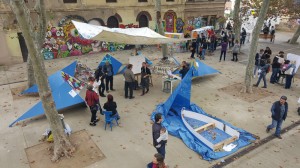
An image of the November 2016 edition of the Ús Barcelona festival, held in Can Ricart in Poblenou. In the background is the dedicated children’s area, Ús Kids.
Photo: Rebobinart
For its part, the City Council centred its efforts on cleaning up graffiti in protected areas classed as being of touristic and commercial interest. But in parallel to this, it began to allow art actions in specific places. The projects took hold and on 1February 2014, the first Ús Barcelona festival was held. This event was funded 50% by the Council with the aim of integrating urban art into the social fabric of the city and to distance it from the notion of vandalism. It brought urban artists together to paint the walls of the old Encants Vells flea market. It was a rainy day, but the festival – which combined urban art with workshops, music, markets, discussion forums, etc. – still attracted more than 6,000 people, mostly families. Ús Barcelona was featured on page one of the newspaper La Vanguardia: proof of the impact it had and how the public’s perception of urban art had changed.
A point of cultural policy
This pace of things has been kept up, which suggests that a new way of making and experiencing urban art could be taking hold. Since 2015 and the arrival of the new city government team, the approach to urban art is based on cultural policy and seen as another tool to democratise and return the urban space to the public and as an instrument of social regeneration.
We now need to advance towards finding stable solutions that benefit all three of the main players involved in this issue. Firstly, the artists. Some authors defend illegality as a way of escaping any kind of external imposition on their creative expression. But is not painting on other people’s property also a form of imposition? In this regard, they need to be reminded that preserving freedom of expression is always a positive thing, but acting outside the law is not an essential requirement to do so.
The second main player is the city government, which needs to be clearly reminded that, while the city must be kept clean, art actions such as the ones mentioned in this article are unavoidable and coercion does not solve anything. The Council should be the first to want to get the help of associations, a range of groups and the general public to find agreed-upon solutions that include offering up available spaces. Aspiring to monopolise the way the issue is managed is a risky business because the Council could be taking on the role of a curator that only accepts a narrow spectrum of artists and consequently forces others to remain outside the law. This would be a new way of imposing a style on the city, from a politicised standpoint and without taking its citizens’ views into account. It is also dangerous for urban art to be relegated to derelict or peripheral areas, because then it loses its power to surprise, its spontaneity, and only reaches the people who deliberately go to visit it. The Council spends €10,800 a day cleaning up graffiti. If a portion of this budget was invested in integrating urban art into the city, offering lots of spaces in many different locations, maybe we wouldn’t need so much cleaning.
And we mustn’t forget the third player, the city’s residents. If citizens don’t understand the rationale behind a project, they will reject it, and artists do attract rejection if they paint on private properties without the approval of owners. The general public must be given a voice and a chance to get involved, and projects must be carried out with a view to making the urban space a space that is experienced and shared. We need to work to make this consensus possible.



